In this digital age, the right camera is your gateway to unlocking the wonders of visual storytelling. Introducing the “Digital Photography Camera for Beginners,” a crucial companion on your creative expedition. Designed with user-friendly features and intuitive controls, these cameras empower novices to capture stunning moments effortlessly. Whether you’re diving into the world of portraits, landscapes, or macro photography, this guide aims to demystify the complexities of choosing the perfect entry-level digital camera. From understanding essential functionalities to unraveling the nuances of composition, join us as we navigate the realm of digital photography, equipping you with the knowledge and tools needed to kickstart your photographic journey with confidence.
Best Product Photography Camera for Beginners
In the market, there are many beginner-friendly product photography cameras. A camera that offers manual controls and high resolution is ideal for beginners. We include the top three cameras for beginners to consider. In the below, we discuss in-depth by keeping beginners in mind.
01. Panasonic LUMIX FZ80 4K Digital Camera
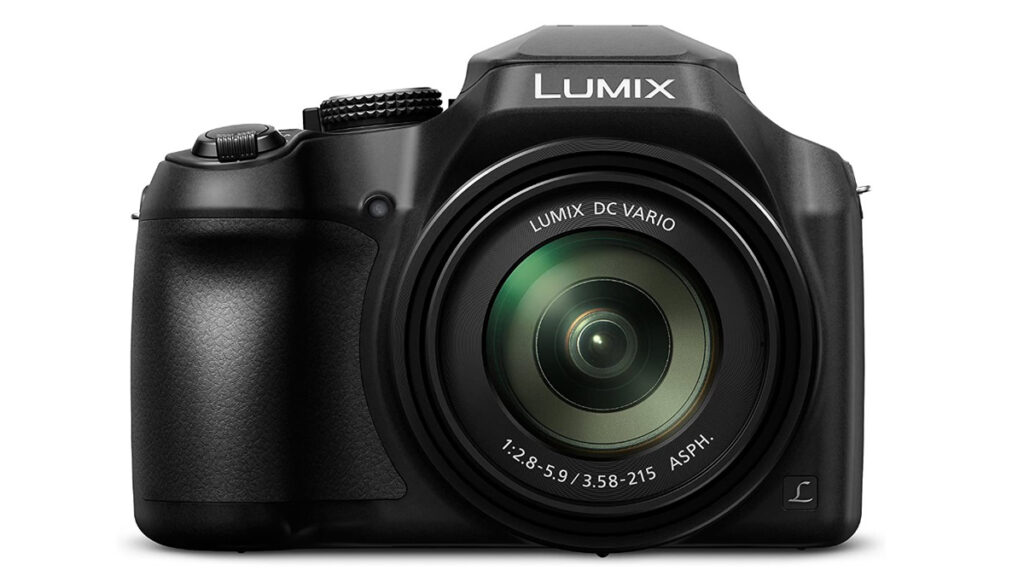
The Panasonic LUMIX FZ80 4K Digital camera is the best choice for travelers. Because the camera has the fantastic optical performance of a super long DC Vario lens 60X (20 1200mm) with Optical image stabilization. The DC Varo lens gives you a super bright F2 8.5.9 aperture range. In the low light situation, to get the striking depth of field dimension into your photograph, the aperture range is optically stabilized with Panasonic’s Power O.I.S. Technology will help you a lot.
Even the post focus and focus stacking will provide flexibility; you can fix the depth of field or focus point anytime after capturing the photo.
The Panasonic LUMIX FZ80, 4K cameras, have a powerful 18.1 MP MOS sensor. It will also allow you to get high-resolution 4K video up to 3840 X 2160 of standard Full HD. Another fantastic feature is, You can capture printable photos with 4K blistering 30 frames in each second. Nice, right?
The Panasonic LUMIX FZ80 will be compatible with holding it in your hand. It has an excellent ergonomic grip and a 3-inch LCD with a high resolution of 1.170K dot, even in clear sunlight. The technology is very convenient for travelers, like USB charging and Wi-Fi Connectivity facility for your mobile. Everyone can efficiently operate this camera and will enjoy it a lot.
Pros:
- This unit is a touchscreen
- Perfect for a low-light environment.
- Easy to operate
Cons:
- No mic input
02. Sony Alpha a6400 Mirrorless Camera
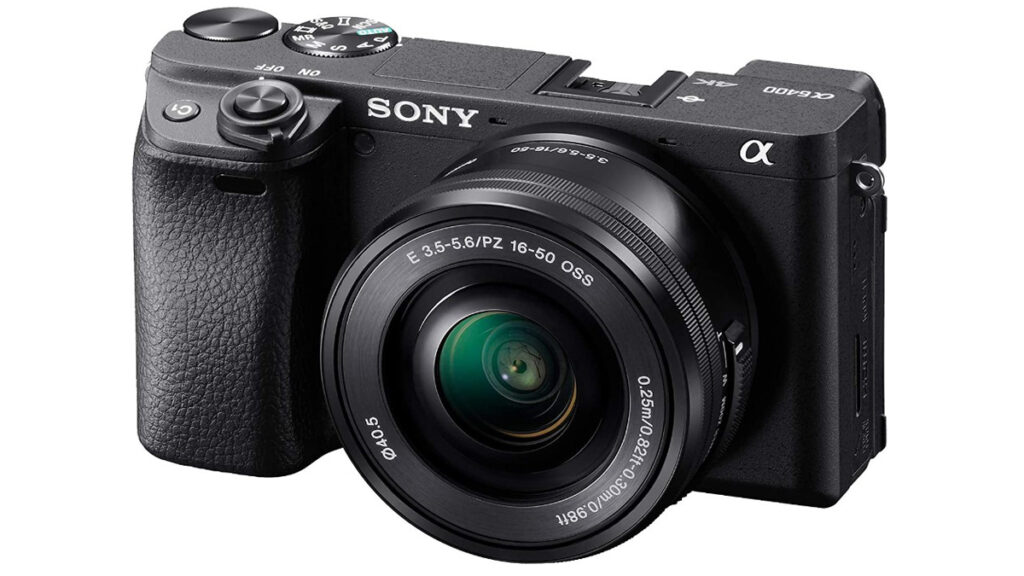
The Sony Alpha a6400 is a mirrorless camera for still photography and video recording. It features a 24.2-megapixel APS-C sensor and a BIONZ X image processor, allowing high-resolution images with minimal noise and excellent low-light performance. The camera also has a fast autofocus system with 425 phase-detection points, allowing quick and accurate focusing even in low-light conditions.
One of the critical features of the Sony Alpha a6400 is its advanced video capabilities. It is capable of 4K video recording with full pixel readout and no pixel binning, which results in sharp, detailed footage. The camera also has advanced video functions such as S-Log3 and H.L.G. (Hybrid Log-Gamma) support, allowing a wide dynamic range and more control over color grading.
The camera also has a built-in electronic viewfinder with a high resolution of 2.36 million dots, which allows for accurate composition and focusing when shooting stills or video. Additionally, the camera has a 3-inch touchscreen LCD that can tilt 180 degrees, which makes it easy to shoot at high or low angles.
Other features of the Sony Alpha a6400 include a fast continuous shooting speed of 11 fps, built-in Wi-Fi and Bluetooth connectivity, and a durable, weather-sealed body. Overall, the Sony Alpha a6400 is an advanced mirrorless camera that offers excellent still and video capabilities, making it a great choice for photographers and videographers.
Pros:
- A High-resolution 24.2-megapixel APS-C sensor and BIONZ X image processor provide excellent image quality.
- A fast autofocus system with 425 phase-detection points allows for quick and accurate focusing.
- Advanced video capabilities, including 4K recording, S-Log3, and H.L.G. support, and full pixel readout with no pixel binning
- Built-in electronic viewfinder with a high resolution of 2.36 million dots for accurate composition and focusing
- 3-inch touchscreen LCD that can tilt 180 degrees for easy shooting at high or low angles
- Fast continuous shooting speed of 11 fps
- Built-in Wi-Fi and Bluetooth connectivity for easy sharing
- Durable, weather-sealed body
Cons:
- Dual card slots are not available
- It does not have a built-in flash
- The camera is relatively expensive compared to other options in its class.
03. Panasonic LUMIX LX10 4K Digital Camera
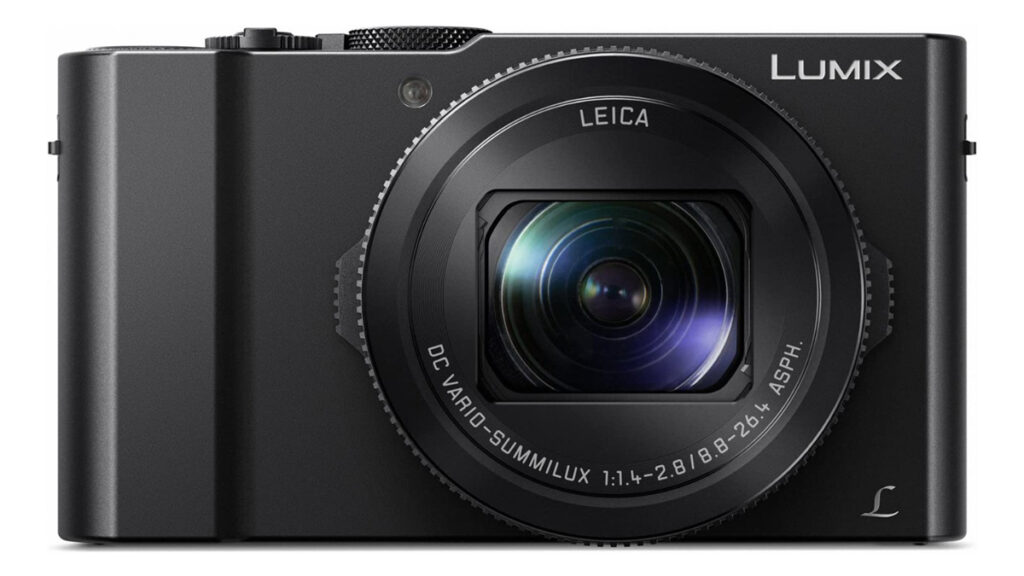
The Panasonic LUMIX LX10 camera is perfect for beginners, and picture quality is excellent, clear, and sharp. If you are planning to carry it while traveling, Panasonic Lumix LX10 is also perfect. The camera is easy to carry and relatively light. It has a good image stabilizer. You can take pictures of moving situations, but this camera will produce apparent and crisp photos.
It is flexible to take general photos in manual mode, which is easy to use. You can adjust methods manually, and the functions are easy to operate. You can capture amazing pictures with blurred background effects by controlling the aperture and shutter speed.
Panasonic may make its camera more user-friendly, like an apple. It is more beneficial for traditional landscape photography and perfect for portrait photography. Because it doesn’t have a zooming option, this can be a problem when capturing close-ups or action shots like moving honey bees, flying butterflies, etc.
You can connect your mobile device using travel-ready technology like USB charging and Wi-Fi.
Pros:
- The picture quality is excellent. Clear and sharp.
- The autofocus is good.
- Battery life was good.
- Accessible data transfer system Wi-Fi is available.
Cons:
- The autofocus is slower than the expectation.
Best Product Photography Camera for Professionals
Professionals are always focused on flexibility but want more control over the camera. So that they can experiment with it in different ways, after our deep research and trial, we will include the top seven product photography cameras that will give you more control and flexibility.
01. Hasselblad X1D II 50C Mirrorless Camera
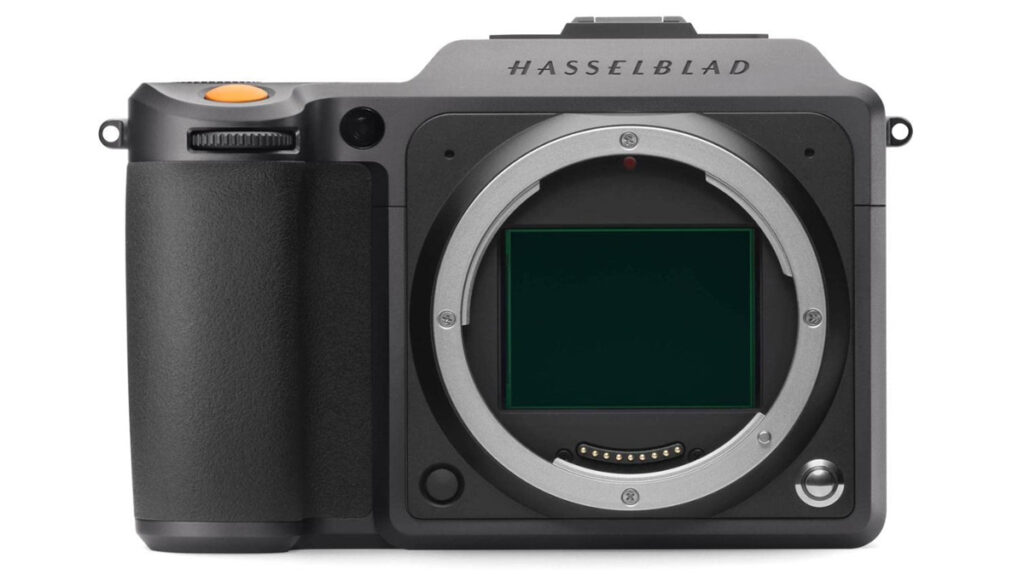
The award-winning design of the first generation Hasselblad X1D || 50C Mirrorless Camera has been packed with a powerful, compact, and enhanced design. This Lightweight and portable camera is best for professional photography. It has an updated electronic platform with an enlarged 3.6-inch Rear Touch display and faster monitoring live refresh rate with an enhanced EVF. User interface options are easy and flexible to use.
The Hasselblad Natural Color Solution technology of this camera will help you to capture a photo with a natural life color tone. Which impressively matches what human eyes see. For the best performance, It has a 50-Megapixel medium format CMOS sensor to create outstanding color depth, and its dynamic range is 14 stops.
It has a powerful USB-C and Wi-Fi connection. You can transfer your camera data quickly to your iPad Pro, Ipad Air, or Mobile devices. The power plugs are designed keeping in mind the U.S. people. If you are from abroad, you may need an adapter or converter to use at your destination.
Pros:
- Lightweight and Portable
- Live view technology
- best in class color and I.Q.
Cons:
- It is a slow camera to autofocus
02. Fujifilm X-T4 Mirrorless Camera
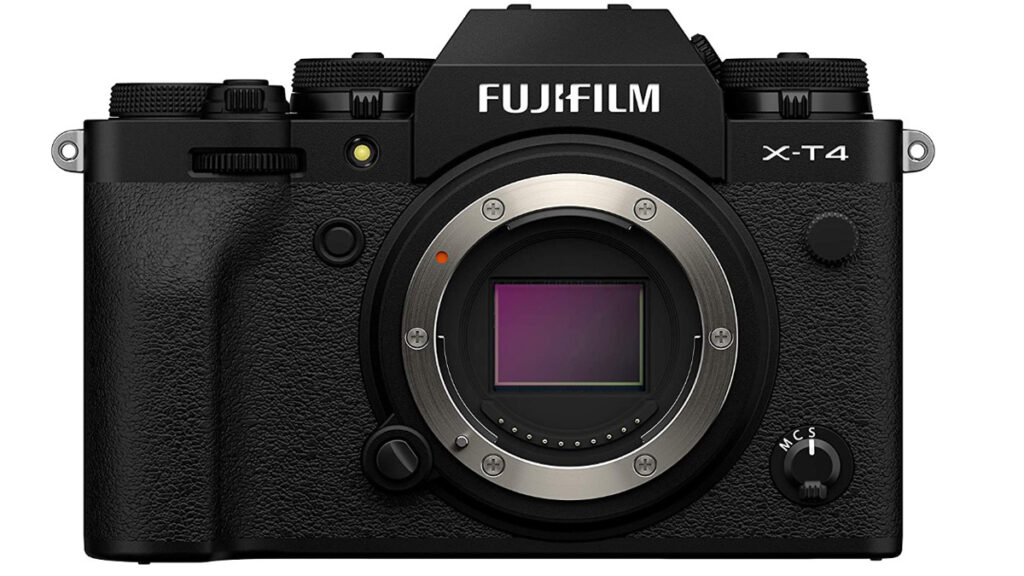
The Fujifilm X-T4 is another excellent professional camera. It is the perfect camera for you if you are a blogger or a professional photographer. The powerful technology of the camera will allow you to produce beautiful photos with just one quick click. You can also record a slow-motion video with full H.D./240p. It also lets you capture high-resolution video footage at 4K/60p with 10-bit color.
The critical thing in creating perfect photos or videos is ensuring you are in the right place at the right time. At this point, it is essential to put the camera in your hand in a stable situation to capture a real-time shoot. The Fujifilm X-T4 mirrorless camera provides up to 6.5 stops of image stabilization opportunities to make sure the images are steady and sharp. For the perfect angle of your photos or videos, The 1.62 million pixel Vari-Angle touchscreen featured on X-T4 can adjust a wide range of positions per your expectation.
The charging ports are designed keeping in mind the U.S.A. people. If you use the camera internationally, you may need to collect an adapter or converter to use at your destination.
The Fujifilm X-T4 mirrorless camera will allow you to transfer data by USB and HDMI.
Pros:
- Longer battery life with the new NP-W235 battery.
- Superb out-of-camera JPGs and video.
- The new ‘floppy’ screen is more flexible for those awkward shots and videos.
- Improved autofocus performance.
Cons:
- External charger not included in the package.
- Autofocus and tracking should be easier to set up than they are.
03. Fujifilm X100V Digital Camera
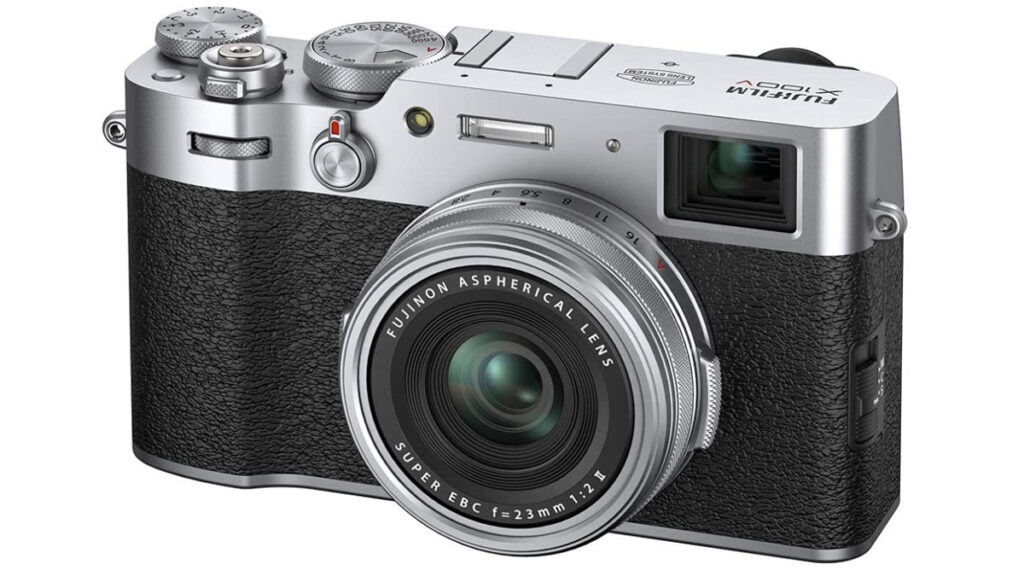
Fujifilm X100V Digital Camera is another perfect choice for the professional to get outstanding daily photography. Perfect street photography camera or just a tremendous carry-around camera when traveling. You will be amazed by its combination of quality and control with its size and simplicity. The X100V also has a powerful X-processor 4 quad-core imaging engine, allowing you to capture super fast with instant autofocus -5EV while an upgraded viewfinder ensures perfect moment captured.
The super addition of a tilting LCD touchscreen and the excellent design will be the best fit for beautiful still images and 4K videos in any situation. The X100V will allow you to explore your imagination and creativity in image-making industries by creating stunning images and 4K videos at 30 frames per second. Additionally, you can capture super slow motion video recording using the camera’s full H.D./120p settings.
The power connectivity options are specially designed for the U.S.A. people. If you are an international user, you may have to collect an additional adapter or converter to use this camera at your destination.
Pros:
- Small enough to always be in your jacket or bag.
- Multi-purpose, compact, high-performing, beautiful camera.
- Great sharp lens
- Small, easy to carry, excellent results.
Cons:
- It is NOT that water resistant
- The battery life seems performance slows down when the battery gets less than 40%
04. Sony Alpha 7R IV Full Frame Mirrorless Camera
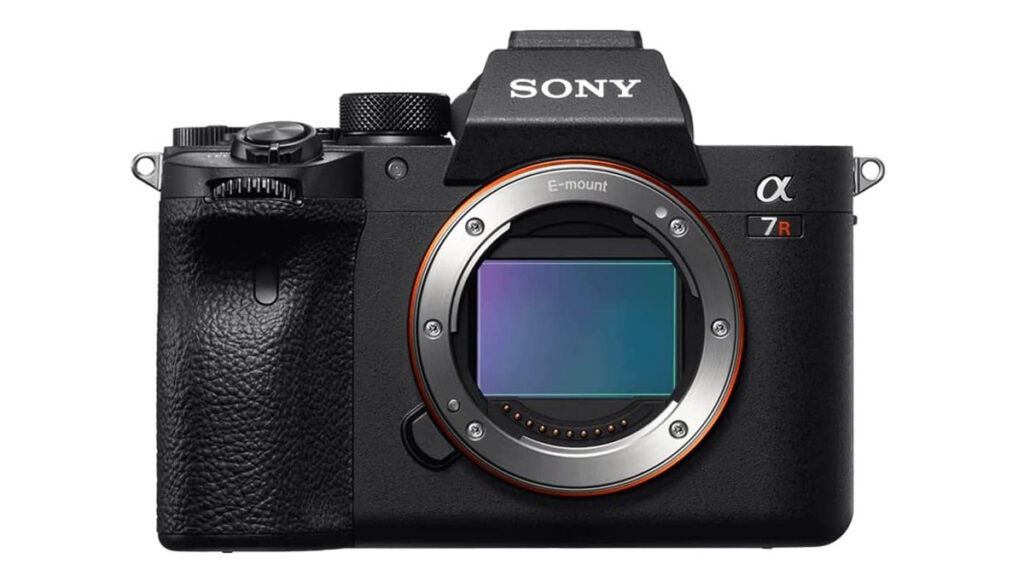
The Sony Alpha 7R IV is a full-frame mirrorless camera designed for professional photographers and videographers. It features a high-resolution 61 M.P. sensor, allowing large print sizes and cropping flexibility. The camera also has a fast autofocus system with 567 phase-detection points and real-time tracking, which makes it easy to capture fast-moving subjects. It also has a 5-axis in-body image stabilization system, which helps to reduce camera shake and produce sharp images and smooth video.
The camera also offers advanced video capabilities, with the ability to shoot 4K resolution video and S-Log3/S-Log2 profiles for color grading. Additionally, it has dual UHS-II SD card slots for added storage and backup options. The camera has a durable and weather-sealed body, making it suitable for shooting in challenging conditions. It is also compatible with a wide range of E-mount lenses.
The Alpha 7R IV also has a high-resolution and high-quality electronic viewfinder for precise focusing and composition. It also has various connectivity options, including built-in Wi-Fi, Bluetooth, and N.F.C., allowing you to easily share your photos and videos and control the camera remotely with your smartphone or tablet.
On the other hand, the camera is relatively expensive, which may make it less accessible for amateur or hobbyist photographers. Additionally, the camera’s battery life may not be sufficient for heavy or extended shooting sessions. The camera is also heavier than other mirrorless cameras, which may not be ideal for long-term handheld use. It also limited lens options compared to other camera systems.
Pros:
- High resolution 61 M.P. sensor allows for large print sizes and cropping flexibility.
- Fast autofocus system with 567 phase-detection points and real-time tracking.
- 5-axis in-body image stabilization for sharper images and smooth video.
- Advanced video capabilities, including 4K resolution and S-Log3/S-Log2 profiles for color grading.
- Dual UHS-II SD card slots for added storage and backup options.
- Durable and weather-sealed body for shooting in challenging conditions.
- Compatible with a wide range of E-mount lenses.
- High-resolution and high-quality electronic viewfinder for precise focusing and composition.
Cons:
- Limited lens options compared to other camera systems.
- A limited number of dedicated buttons may take some time.
- Learning and using the camera’s advanced features can be challenging.
05. Canon E.O.S. 6D Mark II Digital S.L.R. Camera
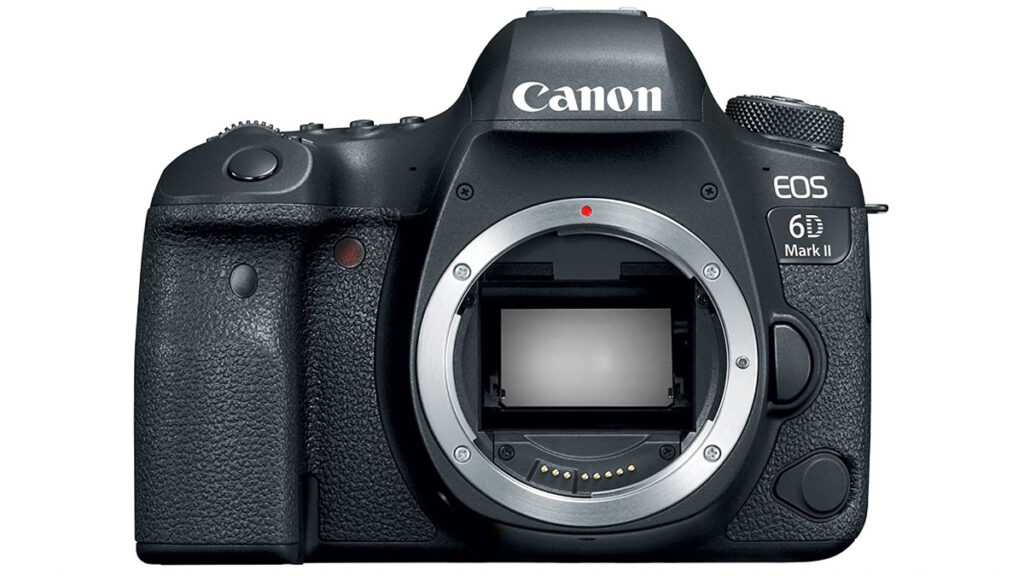
The Canon E.O.S. 6D Mark II is a digital single-lens reflex (DSLR) camera designed for professional photographers and advanced enthusiasts. It features a full-frame 26.2-megapixel sensor, a 45-point all cross-type autofocus system, and Dual Pixel CMOS AF for smooth and fast focusing during live view and video recording. It also has a continuous shooting speed of up to 6.5 frames per second and a maximum ISO of 40,000.
The camera also has built-in Wi-Fi and Bluetooth technology, allowing for easy sharing of photos and videos and easy control of the camera with a smartphone or tablet. It also has a Vari-angle touchscreen LCD that makes it easy to take photos and videos at different angles and navigate through the camera’s menu. Additionally, it is compatible with the full range of Canon E.F. lenses and has built-in G.P.S. for geotagging your images.
The 6D Mark II also has an advanced video recording feature; it can shoot up to Full HD 1080p at 60 fps and has a stereo microphone input for an external mic.
It has a durable and weather-sealed body, making it suitable for shooting in challenging conditions. It is a versatile camera that you can use for a wide range of photography and videography applications. However, it is a relatively heavy camera, which may be better for short-term handheld use. Additionally, it has a relatively short battery life, which may not be sufficient for heavy use or extended shooting sessions.
Pros:
- Full-frame 26.2-megapixel sensor for high image quality and large print sizes.
- 45-point all cross-type autofocus system and Dual Pixel CMOS AF for fast and accurate focusing.
- Continuous shooting speed of up to 6.5 frames per second.
- Built-in Wi-Fi and Bluetooth for easy connectivity.
- Vari-angle touchscreen LCD for easy composition and menu navigation.
- Compatible with the full range of Canon E.F. lenses.
- Built-in G.P.S. for geotagging images.
- The Advanced video recording feature can shoot up to Full HD 1080p at 60 fps
- Durable and weather-sealed body for shooting in challenging conditions.
Cons:
- Relatively heavy camera, which may not be ideal for long-term handheld use.
- A limited number of cross-type autofocus points compared to other cameras in its class.
- It does not have 4K video recording capability, which some users may find limiting.
06. Nikon D750 FX-format Digital S.L.R. Camera
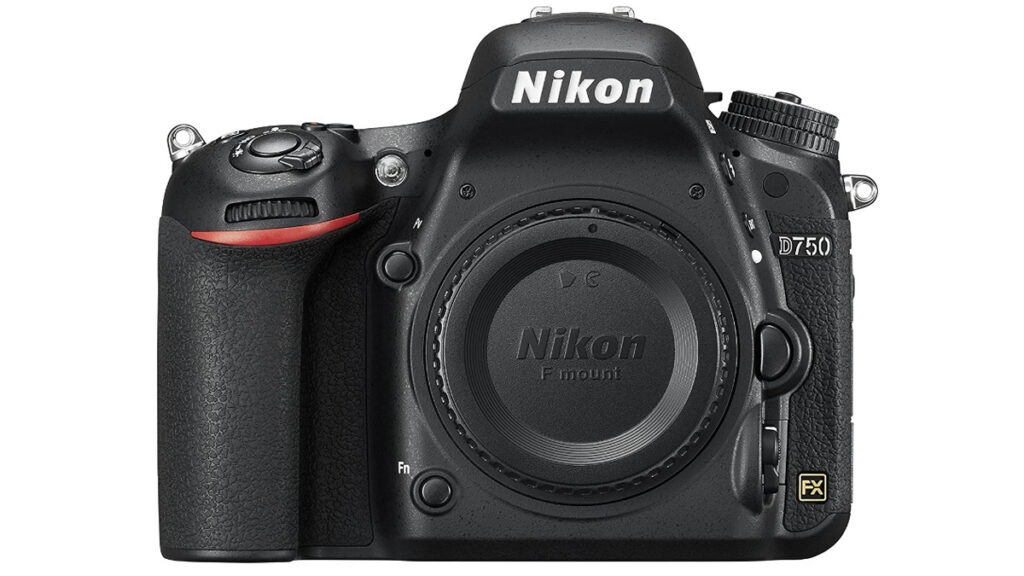
The Nikon D750 is a full-frame (FX-format) digital single-lens reflex (DSLR) camera designed for professional photographers and advanced enthusiasts. It features a 24.3-megapixel sensor, a 51-point autofocus system, and a continuous shooting speed of up to 6.5 frames per second. The camera has a wide sensitivity range of ISO 100-12800, which can be further expanded to ISO 50-51200, making it suitable for low-light shooting.
The camera also has built-in Wi-Fi and Near Field Communication (N.F.C.) which allows for easy sharing of photos and videos and easy control of the camera with a smartphone or tablet. It also has a 3.2-inch Vari-angle LCD, making it easy to take photos and videos at different angles and navigate through the camera’s menu. Additionally, it is compatible with the full range of Nikon F-mount lenses and has a built-in flash.
The D750 also has an advanced video recording feature; it can shoot up to Full HD 1080p at 60 fps and has a stereo microphone input for an external mic. The camera has a durable and weather-sealed body, making it suitable for shooting in challenging conditions.
On the other hand, it is a relatively heavy camera, which may not be ideal for long-term handheld use. Additionally, it has a relatively short battery life, which may not be sufficient for heavy use or extended shooting sessions. The autofocus system is less advanced than some other full-frame cameras. Additionally, Some users may find the camera’s maximum ISO of 51200 insufficient for low-light shooting.
Pros:
- Full-frame 24.3-megapixel sensor for high image quality and large print sizes.
- Continuous shooting speed of up to 6.5 frames per second.
- Built-in Wi-Fi and N.F.C. for easy sharing and remote control.
- Vari-angle LCD for easy composition and menu navigation.
- Compatible with the full range of Nikon F-mount lenses.
- Built-in flash.
- The Advanced video recording feature can shoot up to Full HD 1080p at 60 fps
- Durable and weather-sealed body for shooting in challenging conditions.
Cons:
- Short battery life may not be sufficient for heavy or extended shooting sessions.
- The Autofocus system is less advanced than some other full-frame cameras.
- It does not have 4K video recording capability, which some users may find limiting.
07. Canon E.O.S. Rebel T7 DSLR Camera
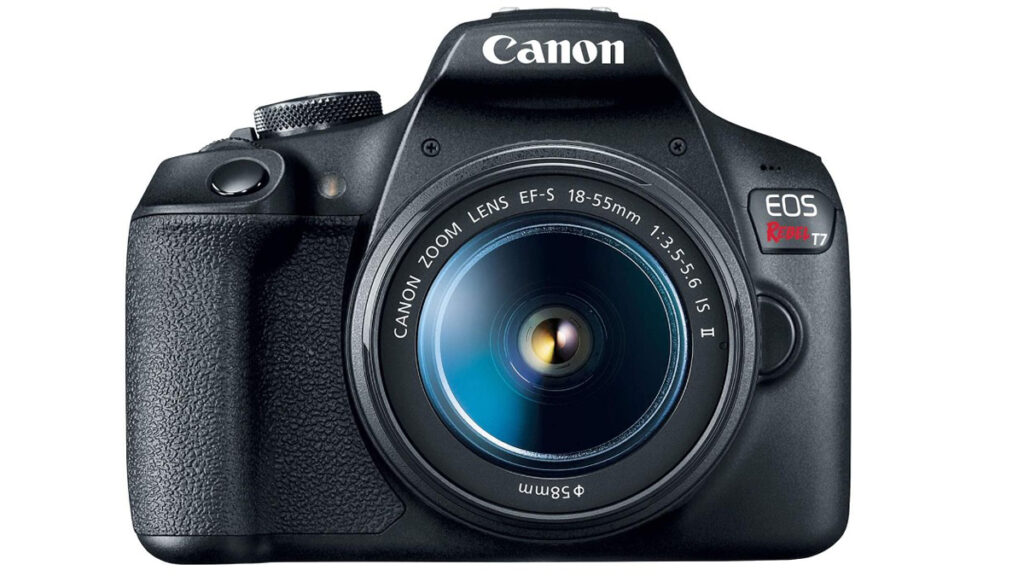
The Canon E.O.S. Rebel T7 (also known as E.O.S. 2000D) is a digital single-lens reflex (DSLR) camera designed for entry-level or beginner photographers. It features a 24.1 megapixel APS-C sensor, a 9-point autofocus system, and a continuous shooting speed of up to 3 frames per second. The camera has a wide sensitivity range of ISO 100-6400, which can be further expanded to ISO 12800, making it suitable for low-light shooting.
The camera also has built-in Wi-Fi and N.F.C. (near field communication), which allows for easy sharing of photos and videos and easy control of the camera with a smartphone or tablet. It also has a 3-inch LCD screen, making it easy to take photos and videos and navigate through the camera’s menu. Additionally, it is compatible with the full range of Canon E.F. and EF-S lenses.
The E.O.S. Rebel T7 also has an essential video recording feature, and it can shoot up to Full HD 1080p at 30 fps. The camera is lightweight and compact, making it suitable for on-the-go photography. It also has a built-in flash.
On the other hand, the camera has a relatively basic autofocus system, which may be slower and more accurate than other DSLR cameras. Additionally, the camera’s battery life may not be sufficient for heavy or extended shooting sessions. The camera does not have advanced features such as 4K video recording or a high-resolution viewfinder.
Pros:
- 24.1 megapixel APS-C sensor for high image quality.
- 9-point autofocus system for basic focusing capabilities.
- Built-in Wi-Fi and N.F.C. for smooth connectivity
- 3-inch LCD screen for easy composition and menu navigation.
- Compatible with the full range of canon E.F. and EF-S lenses.
- The essential video recording feature can shoot up to Full HD 1080p at 30 fps.
- Lightweight and compact design for on-the-go photography.
- Built-in flash.
Cons:
- Short battery life may not be sufficient for heavy or extended shooting sessions.
- The maximum ISO is 12800, which may not be suitable for low-light photography.
- The camera is not weather sealed, making it less suitable for challenging conditions.
- Some users may need help navigating the camera’s menu system.
Guide to Choosing a Camera for Digital Photography
Nowadays, you should budget significantly when buying a camera. Because buying a professional camera is a significant investment. For this reason, it is essential to choose the right camera before buying. A wise decision will save you money. To avoid unwanted cameras, take some time to do homework and discover why and your expectations of buying a camera.
Perfect Sensor Size:
Professional photographers usually like a 35mm full-frame sensor, and its dimensions are typically 36x24mm. This type of sensor helps to produce high-quality images.
Good Resolution:
If you want clear and crisp images, you can try 12MP and 4K. In comparison, those two options are close in pixels per foot. It will allow you to view even more details while it’s a deeper zoom.
D.P.I.:
D.P.I. means dot per inch. It refers to the number of printed dots in the area of one inch of the image. You will get the perfect result from your photos between 200 dpi to 600 dpi. It is essential while you are going to print your photo.
Screen Type:
Screen type depends on the different uses and types of cameras. For a DSLR camera, you can try a 5-inch external camera screen. It is a good choice if you want to buy a large camera that supports a 7-inch external screen.
Shooting Rate:
Most modern DSLR cameras usually have continuous shooting rates of between 3 and 8 frames per second. However, some high-end cameras can capture 14 to 16 frames per second with full autofocus mirror lock-up mode.
Focal Length:
The focal length for a standard lens is between 35mm and 50mm. Human eyes and focal length are almost similar. Those types of lenses are usually used for naturalistic and cinematography tasks.
Battery Life:
There is no exact time frame for battery life. It depends on various things. In the market, there are different types and sizes of batteries. Just to confirm that you get a minimum warranty for the battery life.
After checking all those things from the above list, test the camera In various lighting conditions and different autofocus modes to check that all the functions are working correctly.
The Lenses You Need for Product Photography Camera
Product photography is a specific type of photography that involves capturing images of products in a way that highlights their features and attributes. To achieve this, certain types of lenses are more suitable than others. Here are a few lenses commonly used in product photography:
Macro lenses:
These lenses are designed to capture images at very close distances, which is ideal for product photography as they allow you to capture intricate details of small products. They have a large maximum aperture, which allows you to shoot with a shallow depth of field and isolate your subject from the background.
Zoom lenses:
Zoom lenses allow you to change the focal length without changing the lens, which is helpful for product photography as it allows you to adjust the perspective of your subject without moving the camera. They are beneficial for capturing images of more oversized products or groups of products.
Fisheye lenses:
These lenses have a wide-angle view and create a distorted, spherical image that you can use to create unique and exciting perspectives in product photography. They can create a sense of depth and spaciousness in your images.
Tilt-shift lenses:
These lenses allow you to adjust the angle of the lens concerning the camera body, which can be helpful for product photography as it allows you to control the angle of view and perspective of your subject. They are handy for capturing images of products with irregular shapes or surfaces.
Mirror lenses:
They are very compact and lightweight, making them ideal for product photography as they are easy to use and move around the studio. They are also helpful for close-up shots and can create a unique and exciting shallow depth-of-field effect.
It is important to note that some lenses are more versatile than others and can be used in various situations. It’s essential to evaluate the specific needs of your product photography projects and choose the appropriate lenses accordingly.
Final Words
Regarding product photography, the best camera will vary depending on the specific needs and requirements of the photographer. In conclusion, the product photography is a specific type of photography that requires the use of specific cameras and lenses to achieve the desired results. Each camera and lens has its strengths and weaknesses; it’s essential to evaluate the specific needs of your product photography projects and choose the appropriate camera or lenses accordingly. However, it’s important to note that the camera is only one piece of the puzzle. The right lenses, lighting, and editing software will also play a crucial role in achieving the desired results in product photography.
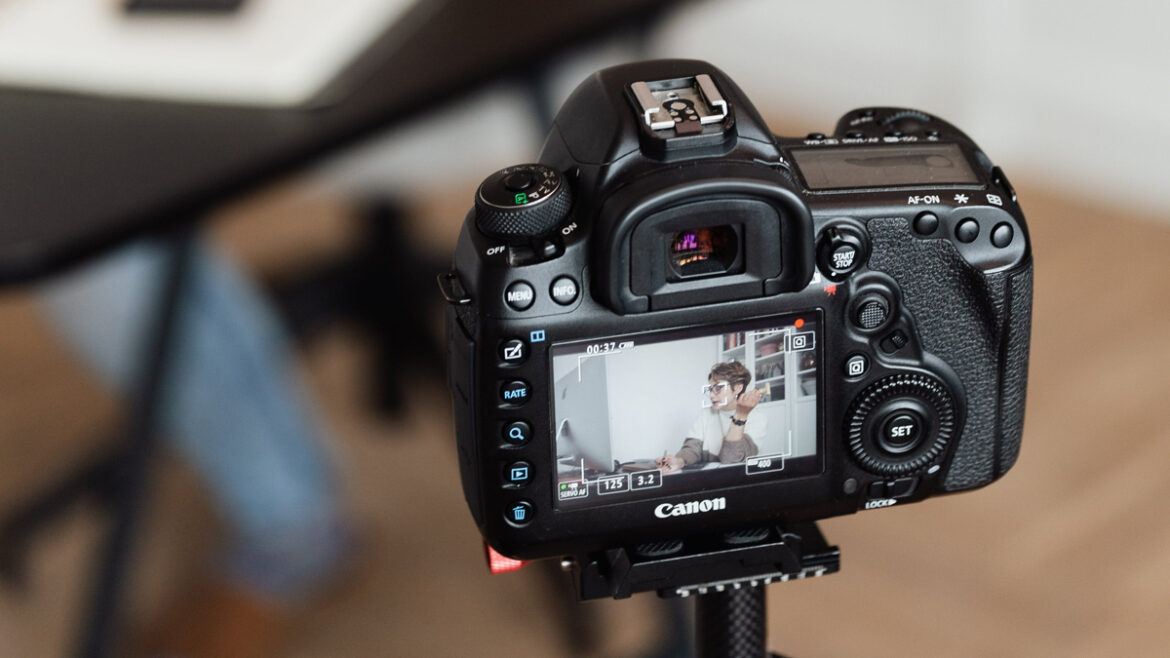
1 comment
Pretty! This has been a really wonderful post. Many thanks for providing these details.